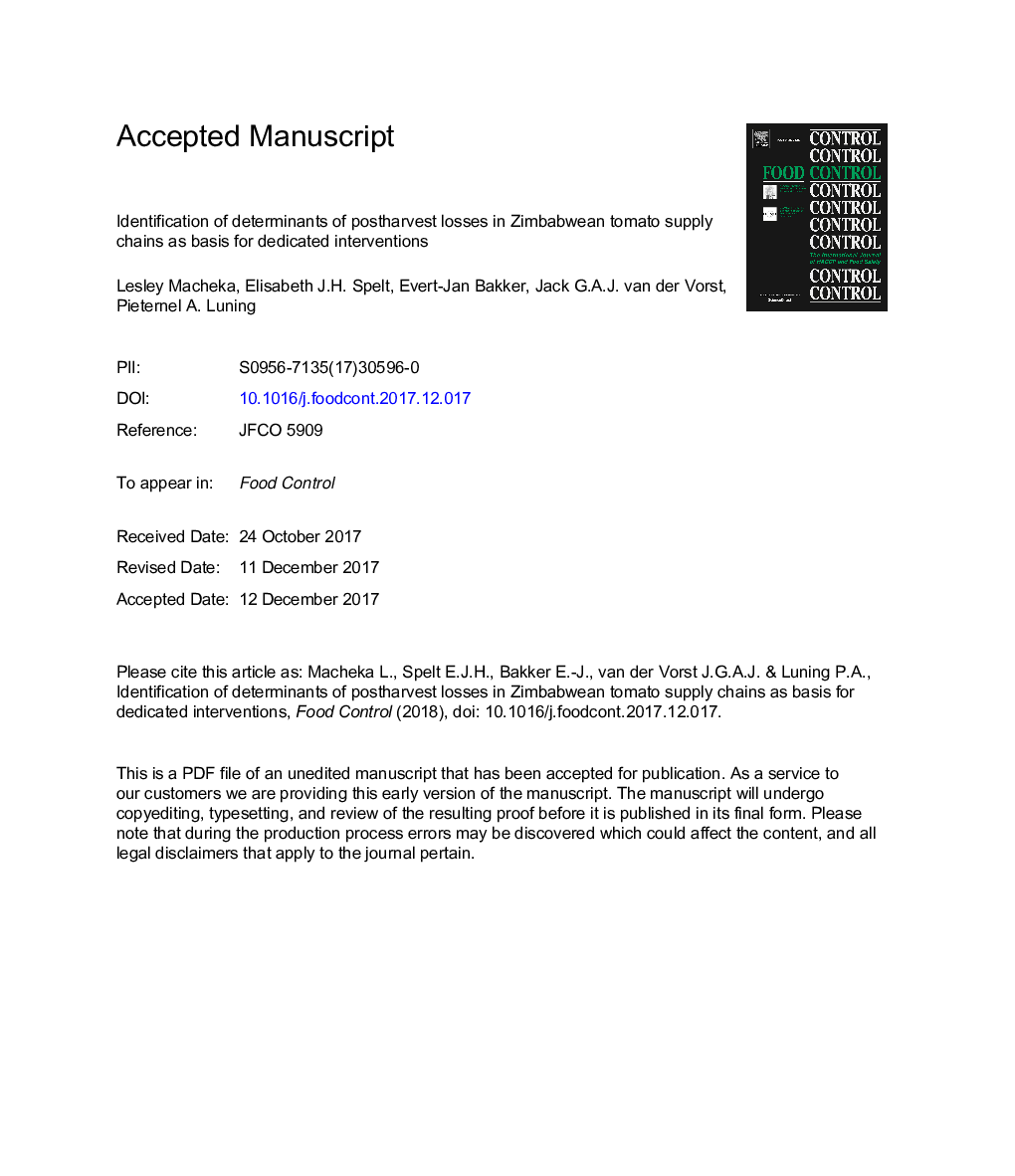| کد مقاله | کد نشریه | سال انتشار | مقاله انگلیسی | نسخه تمام متن |
|---|---|---|---|---|
| 8888078 | 1628377 | 2018 | 30 صفحه PDF | دانلود رایگان |
عنوان انگلیسی مقاله ISI
Identification of determinants of postharvest losses in Zimbabwean tomato supply chains as basis for dedicated interventions
ترجمه فارسی عنوان
شناسایی عوامل تعیین کننده پس انداز تلفات در زنجیره تامین زیتون به عنوان مبنای مداخلات
دانلود مقاله + سفارش ترجمه
دانلود مقاله ISI انگلیسی
رایگان برای ایرانیان
کلمات کلیدی
تلفات پس از رسیدن، کنترل لجستیک، کنترل کیفیت، ابزار تشخیصی، کشاورزان معیشت، کشاورزان بازرگانی، مداخلات،
موضوعات مرتبط
علوم زیستی و بیوفناوری
علوم کشاورزی و بیولوژیک
دانش تغذیه
چکیده انگلیسی
Postharvest losses (PHL) are a major problem in tomato supply chains, especially in tropical climates, as up to 40% of harvested fruits are estimated to decay along the chain. The study aimed at identifying which farmers' context characteristics, logistics and quality control activities relate with the generation of PHL in tomato supply chains, particularly in Zimbabwe. Commercial and subsistence tomato farmers (nâ¯=â¯197) from five major tomato-growing areas were analysed using a diagnostic tool to assess the status of logistics and quality control activities, the vulnerability of farmers' context, and the actual PHL. Hierarchical cluster analysis resulted in three clusters of farmers grouped based on similarities on context vulnerability and status of logistics and quality control activities. Spearman's rank correlation analysis and multiple linear regression analyses revealed that more advanced logistics and control activities, and context characteristics with a lower vulnerability to PHL are associated with less postharvest losses. The context characteristics, features of storage facilities, features of cropping system, and market price stability were significant determinants (pâ¯<â¯.05) and explained 29% (Adjusted R2â¯=â¯0.287) of the variation in the PHL. The logistics control activity, determining processing volumes was identified as a possible determinant (pâ¯<â¯.05) and explained 21% (Adjusted R2â¯=â¯0.205) of the variation in the observed PHL. The quality control activities, deciding on maturity to harvest, deciding on moment to harvest, and storage practices were the identified determinants (pâ¯<â¯.05), which explained 23% (Adjusted R2â¯=â¯0.230) of the variability in the observed postharvest losses. A framework of intervention strategies tailored to tomato farmers' development stage is proposed to support them in a step-wise improvement of logistics and quality control practices to reduce PHL and advance towards more advanced supply chains.
ناشر
Database: Elsevier - ScienceDirect (ساینس دایرکت)
Journal: Food Control - Volume 87, May 2018, Pages 135-144
Journal: Food Control - Volume 87, May 2018, Pages 135-144
نویسندگان
Lesley Macheka, Elisabeth J.H. Spelt, Evert-Jan Bakker, Jack G.A.J. van der Vorst, Pieternel A. Luning,
